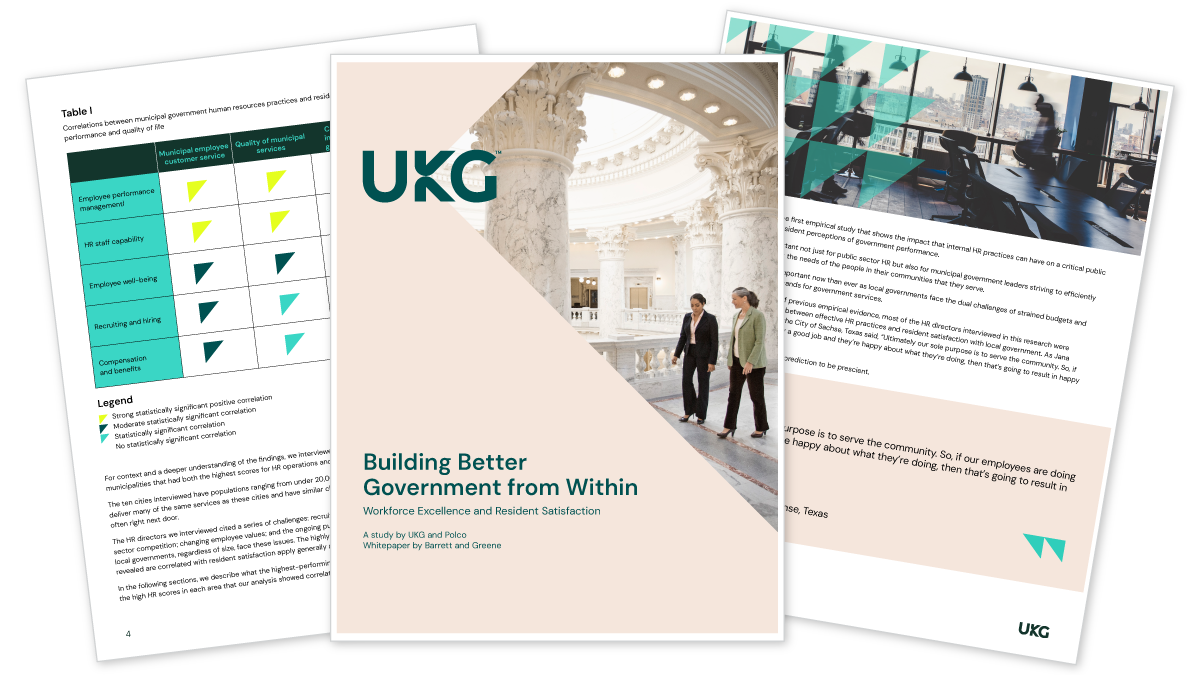Do Better HR Practices in City Government Lead to Better Outcomes for Residents?
By Polco on October 8, 2025

Cities work best when the people who work for them are supported, trained, and managed well. But can good HR really make a difference in how residents feel about their local government?
In the private sector, research has revealed a substantial link between HR policies and company profit, market value, and cash flow. Moreover, research on the private sector has shown that a positive employee experience correlates with a positive customer experience (and therefore with financial outcomes).
However, the relationship between effective HR practices and outcomes is more difficult to document in the public sector, which does not have the same financial measures
A new study led by UKG, Polco, and Barrett & Greene put that question to the test. We began with a matrix of leading HR practices developed by Bob Lavigna from UKG, which we reviewed with a focus group of HR directors facilitated by Katherine Barrett and Richard Greene to revise and refine so that we captured the essential ways local government HR operates. Building on that input, we developed a 73-item survey instrument measuring 15 dimensions of HR policy and program effectiveness. These included HR mission and policies, recruitment and hiring, retention, training and development, technology, data, performance management, employee grievances, compensation and benefits, workforce and succession planning, working conditions, employee wellbeing, diversity, and labor relations.
As The National Community Survey™ measures many aspects of local government performance and community livability, the 238 municipalities that have conducted this survey at least once in the years 2022, 2023 and 2024 were chosen as the study sample.
Four survey items from The NCS were chosen as the outcomes of resident perception:
- customer service of municipal staff,
- confidence in municipal government,
- quality of services provided by municipal government, and
- quality of life in the community.
HR leaders from these 238 municipalities were invited to participate in the survey. Completed surveys were received from 52 communities, for a 22% response rate. Scores were created for each of the 15 HR domain areas by averaging the survey items from each domain. These scores ranged from 0 to 100. Likewise, the four resident perception outcomes from The NCS items were calculated as an average on a 100-point scale. A Pearson’s correlation coefficient was examined for the relationship between each HR domain and each outcome.
The analysis showed that municipalities with stronger HR practices also score higher on resident satisfaction with customer service, government services, trust in government, and overall quality of life (see the table below). In other words: people notice when city employees are supported to do their best work.

Despite the absence of previous empirical evidence, most of the HR directors interviewed by Barrett and Greene in support of this research were unsurprised by the link between effective HR practices and resident satisfaction with local government. As Jana Ventura, HR director in the City of Sachse, Texas said, “Ultimately our sole purpose is to serve the community. So, if our employees are doing a good job and they’re happy about what they’re doing, then that’s going to result in happy residents.”
Investing in effective HR is not just about improving internal operations, it is a community investment. This research demonstrates that when local governments strengthen HR practices, residents respond with greater confidence in their government and higher satisfaction with the quality of services provided. HR departments can use these findings as proof that strategic attention to people and performance pays off. Regularly measuring community satisfaction ensures that progress continues, helping cities deliver ever better services and quality of life.
Popular posts
Sign-up for Updates
You May Also Like
These Related Stories

5 HR Practices That Matter Most for Residents

Aligning Employee Goals with the City’s Mission

